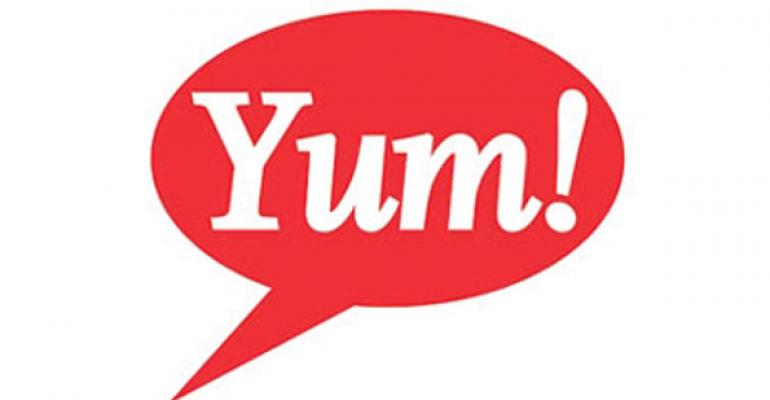Yum! Brands Inc. plans to double Taco Bell’s domestic annual sales to $14 billion by 2021, according to two securities analysts who attended investor meetings with the company Tuesday.
Louisville, Ky.-based Yum, which also operates and franchises KFC and Pizza Hut, told attendees that system growth would include an increase in average unit volumes from $1.3 million in fiscal 2012 to about $1.8 million by the end of the decade, as well as growing its unit count from 5,700 to 8,000 locations.
RELATED
• Yum: 'No truth to rumors' in mutton supply controversy
• Yum 1Q profit drops 27%
• More quick-service news at NRN.com
According to research notes from Andy Barish of Jefferies Group and David Tarantino of Robert W. Baird, Yum officials were bullish on Taco Bell’s chances of doubling its $7 billion in sales in 2012, based on the brand’s daypart expansions, menu line extensions, unit-growth opportunities and marketing.
Driving AUVs via the menu
Taco Bell plans to get the majority of the $7 billion increase in incremental sales by 2021 by growing average unit volumes with more menu items and more dayparts, the analysts wrote.
Tarantino noted that Taco Bell management was optimistic about the chain’s ability to drive same-store sales in the afternoon snack daypart, where it holds a 1.2-percent market share, compared with its 3-percent share of quick-service sales for lunch and dinner. He added that the “Happier Hour” initiative in which Taco Bell promoted Loaded Grillers contributed greatly to the chain’s 6-percent increase in first-quarter same-store sales.
He also wrote that Taco Bell has successfully tested breakfast, mostly in the West, and intends to roll out the morning meal systemwide by 2014. Its breakfast lineup includes a crunchy breakfast wrap, bite-size Cinnabon-branded cinnamon rolls, oatmeal, yogurt parfaits and coffee.
Barish noted that line extensions in the works for Taco Bell include a Flamas-flavored Doritos Locos Taco, shredded chicken on the main menu and new Mountain Dew frozen beverage flavors. The Cantina Bell menu will get steak quesadillas and fajitas this year, Barish wrote, “and though sales mix is currently around 4 percent of sales — skewing toward females, over-35 [customers] and higher incomes — the platform continues to drive improvements in customer perceptions about Taco Bell’s quality and freshness.”
He added, “We see a long runway for Taco Bell’s innovative platforms and like the focus on store economics and brand engagement.”
New buildings for building sales
The more than 2,000 new locations Taco Bell projects it could open would account for the remaining $3 billion in incremental sales, based on 2012’s average unit volumes, Barish noted. That would dictate a pace of opening between 100 and 130 restaurants this year, double that range in 2014 and 2015, and then about 200 openings per year.
“Yum sees a big opportunity in rural areas and thinks about half of the new units can be in Small Town, USA,” Barish wrote, “with 700 to 800 stores in the concept’s current sweet spot, suburban markets. Taco Bell is also moving slowly into urban markets and has developed flexible models, including an in-line prototype, to execute on the 200-to-300-unit opportunity.”
The chain also disclosed several details of its revised franchise agreements, Barish added, including an increase in the franchise term to 25 years, with a required remodel halfway through. The new arrangement for required franchisee contributions to the national marketing fund does away with local-marketing spending in favor of all-national advertising.
Más “Live Más”
Barish wrote that the shift toward more national marketing would be significant for Taco Bell, resulting in an increase between 35 percent and 40 percent to its gross ratings points, a measurement marketers use to quantify the size of an audience for a given advertising campaign.
“The new national-only marketing program … allows Taco Bell to support breakfast without putting lunch or dinner occasions at risk,” he wrote, also noting that breakfast accounted for 5 percent of sales mix with very little marketing support in the 800 locations in the West where it was tested.
“While Taco Bell will continue to develop new flavors and improve ingredients in the kitchen, we were most impressed by the ways in which the company interacts with guests to build brand loyalty,” Barish wrote. “Management has used the increased national media to cultivate an almost lifestyle brand that Millennials can connect with and then utilizes social and digital tools to amplify this relationship.”
Both he and Tarantino of Robert W. Baird wrote that they were impressed with the continued strength of Taco Bell’s “Live Más” tagline and branding, as well as the heavy emphasis and resources put toward strengthening that positioning via social media.
“Taco Bell has developed an innovative ‘Fishbowl’ that serves as a dedicated center in which marketing employees monitor news flow and consumer chatter about the brand, while generating active online dialogue with customers that helps to amplify the brand message,” Tarantino wrote. “As an example of the power of this approach, the Fishbowl execution helped Taco Bell realize over 2 billion [social-media] impressions for Cool Ranch Doritos Locos Tacos before the launch of the product.”
Irvine, Calif.-based Taco Bell produces as much as 20 percent of Yum’s total annual profit, Tarantino noted.
Yum operates or franchises more than 39,000 restaurants in more than 130 countries.
Contact Mark Brandau at [email protected].
Follow him on Twitter: @Mark_from_NRN





